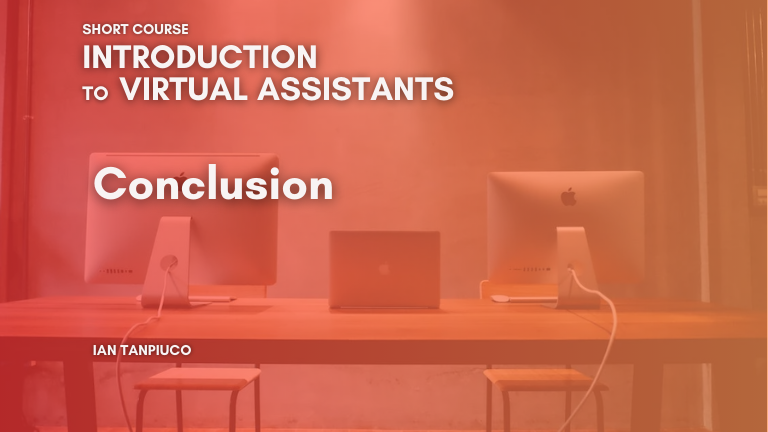
Intro To VA: Conclusion
Key Takeaways from the Course
In conclusion, this course offers valuable insights for those aspiring to become Virtual Assistants (VAs). You’ve learned that a VA provides essential support to businesses remotely, helping them save time and operate more efficiently. Understanding the differences between a VA and a freelancer clarifies the long-term, ongoing nature of VA roles compared to project-based freelance work. While freelancers focus on individual projects, VAs often build long-term relationships with clients, providing continuous support for various business operations.
Types of Virtual Assistants
As you consider this career path, remember the various types of VAs—such as General Admin, Social Media, Customer Support, and E-commerce VAs—and the specific responsibilities each entails. Each type of VA has its own set of duties, so identifying your area of interest or expertise is important for offering specialized services. For example, General Admin VAs handle tasks like managing emails and schedules, while Social Media VAs focus on creating and managing content across different platforms.
Essential Tools for VAs
Equipping yourself with the right tools is vital for effective collaboration. From communication platforms like Zoom and Slack to task management systems such as Trello or Asana, these tools help ensure smooth operations between you and your clients. By mastering these platforms, you can stay organized, maintain transparency with clients, and complete tasks efficiently. Time management and file-sharing tools, like Toggl and Google Drive, are also essential for keeping track of your work hours and sharing documents seamlessly.
Adopting the Right Mindset
Adopting the right mindset is crucial for success. Embrace professionalism by treating each task with care and dedication. Maintain clear communication with clients to avoid misunderstandings and ensure smooth collaboration. Managing your time effectively is equally important, especially when working with clients from different time zones. Be open to learning new skills, whether they are technical or soft skills, to enhance your services and remain competitive in the industry.
Overcoming Challenges and Growing with Experience
Be prepared for initial challenges, such as finding clients and adapting to their preferences, but know that with experience comes growth. The more clients you work with, the more you will understand how to navigate different expectations and work styles. With this experience, you’ll also have the opportunity to increase your rates and expand your services, allowing you to earn more and take on more fulfilling projects.
Building Your Career as a Virtual Assistant
By building a strong portfolio, exploring job platforms, and setting competitive rates, you can establish a rewarding career as a Virtual Assistant. Showcasing your skills through a well-organized portfolio helps potential clients see what you bring to the table, while using platforms like Upwork and LinkedIn helps you find job opportunities. Setting fair and competitive rates, especially as you gain more experience, is key to maintaining long-term success.
Conclusion
Embrace this journey, and you’ll be well on your way to thriving in this dynamic and flexible profession. By continuously improving your skills, staying professional, and positioning yourself effectively in the market, you can build a lasting career as a Virtual Assistant.
- Check Introduction to Virtual Assistants Course Overview
- Check other posts for this course.
Check my other works at Educatorian, IELTS Rizz and IELTS WE

Ian Tanpiuco is an ESL and virtual assistant. With a decade of experience, he has become an expert in his field. Dedicated to helping others achieve their goals, Ian works tirelessly in the classroom or as a virtual assistant.

